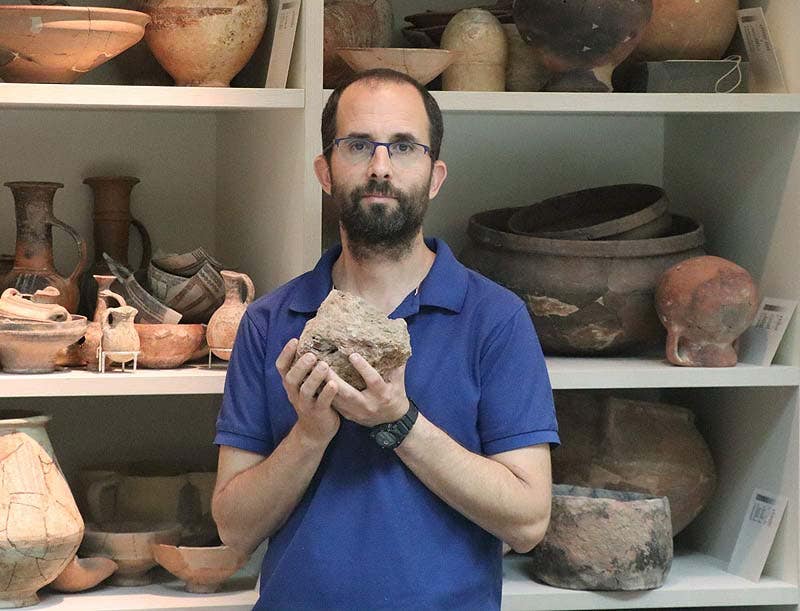Major scientific breakthrough confirms ancient biblical events
Archaeomagnetic dating reshapes our understanding of biblical history, military campaigns, and Earth’s magnetic field changes.

Yoav Vaknin holding a burnt mudstone. (CREDIT: Shai Halevi, Israel Antiquities Authority)
Reconstructing history often demands more than reading ancient texts or uncovering ruins. By integrating archaeomagnetic research with archaeology, scientists have uncovered new insights into the events described in the Hebrew Bible, particularly the military campaigns against the kingdoms of Israel and Judah during the 10th to sixth centuries BCE.
These findings not only deepen our understanding of ancient history but also reshape our comprehension of Earth’s magnetic field and its behavior during this period.
The Hebrew Bible and Near Eastern texts recount numerous military campaigns by powerful neighbors like the Egyptians, Arameans, Assyrians, and Babylonians.
While some destruction layers unearthed by archaeologists have been confidently linked to specific historical events, many remain disputed. These unresolved cases challenge efforts to verify the biblical narrative and reconstruct the scale of these campaigns.
An interdisciplinary study, led by researchers from Tel Aviv University and the Hebrew University of Jerusalem, has employed archaeomagnetic methods to address these chronological gaps.
Published in Proceedings of the National Academy of Sciences, the study analyzes magnetic records preserved in burnt mud bricks and ceramics from 17 sites across Israel. By comparing the intensity and direction of the Earth's magnetic field recorded during these ancient fires, researchers created a chronological framework to date destruction events.
This method complements traditional radiocarbon dating, offering a novel perspective on the timeline of ancient military campaigns.
Magnetic minerals in materials subjected to intense heat—such as those in ancient fires—retain a record of the Earth's magnetic field at the moment of heating. This property enables scientists to reconstruct the geomagnetic field’s behavior over time.
Related Stories
The researchers leveraged decades of archaeological discoveries and combined them with historical inscriptions and biblical accounts to analyze 21 destruction layers. Their work has confirmed key events and challenged long-held assumptions.
One compelling outcome of this research involves King Hazael of Aram-Damascus, a prominent figure in biblical and historical accounts. Previous studies suggested Hazael’s campaign destroyed several sites, including Gath of the Philistines, Tel Rehov, Tel Zayit, and Horvat Tevet.
By synchronizing the magnetic records from these locations, the researchers demonstrated that all four sites were indeed destroyed during the same campaign, around 830 BCE. This breakthrough confirms Hazael’s far-reaching conquests.
However, the findings complicate earlier theories regarding Tel Beth-Shean, a site previously attributed to Hazael’s campaign.
Instead, the magnetic signatures suggest its destruction occurred 70–100 years earlier, aligning it with Pharaoh Shoshenq’s military expeditions. This conclusion aligns with Egyptian inscriptions and biblical accounts, offering a revised timeline for regional conflicts.
The study also addresses the fall of the Kingdom of Judah, one of the most debated episodes in biblical history. Archaeological evidence has long suggested that Judah’s demise under Babylonian forces in 586 BCE was incomplete, as some cities in the southern region remained untouched.
Magnetic data supports this, indicating that sites in the Negev and surrounding areas survived the Babylonian conquest only to be destroyed decades later by the Edomites. This betrayal, highlighted in biblical texts, adds depth to the historical record of Judah’s decline.
Prof. Erez Ben-Yosef explains, “The magnetic results support the hypothesis that the Babylonians were not the sole agents of Judah’s destruction. This challenges conventional views and underscores the complexity of the region’s history.”
The implications of this research extend beyond archaeology. Earth's magnetic field, crucial for shielding life from cosmic radiation, is generated by turbulent flows of liquid iron in the planet’s outer core.
Geophysicists have long assumed the field changes slowly over decades, but archaeomagnetic studies reveal that dramatic shifts occurred in antiquity. During the period studied, the magnetic field in the Southern Levant exhibited unusually rapid changes and spiked to more than twice its current intensity.
Prof. Ron Shaar, who led the geophysical analysis, emphasizes the significance of these findings: “Our results show that the magnetic field is far less stable than previously thought. This knowledge is vital for understanding Earth's core dynamics and refining geophysical models.”
Israel’s wealth of well-dated archaeological sites has made it an ideal laboratory for archaeomagnetic research. Over the past decade, researchers reconstructed the magnetic field using hundreds of artifacts, culminating in a continuous variation curve for the region. This curve not only aids in dating ancient materials but also provides insights into the extreme changes in Earth's magnetic field.
Yoav Vaknin, the study’s lead author, highlights the broader implications: “We’ve developed a scientific dating tool akin to radiocarbon dating, but based on magnetic field variations. This interdisciplinary approach allows us to confirm or challenge historical hypotheses with unprecedented precision.”
This integration of archaeomagnetism with archaeological and textual evidence showcases the power of collaboration across scientific disciplines. It transforms how we understand ancient history and deepens our grasp of Earth's geomagnetic complexities.
As researchers refine this dating method and explore its applications, they are not only unraveling the past but also illuminating the dynamic processes shaping our planet.
Note: Materials provided above by The Brighter Side of News. Content may be edited for style and length.
Like these kind of feel good stories? Get The Brighter Side of News' newsletter.
Rebecca Shavit
Science & Technology Journalist | Innovation Storyteller
Based in Los Angeles, Rebecca Shavit is a dedicated science and technology journalist who writes for The Brighter Side of News, an online publication committed to highlighting positive and transformative stories from around the world. With a passion for uncovering groundbreaking discoveries and innovations, she brings to light the scientific advancements shaping a better future. Her reporting spans a wide range of topics, from cutting-edge medical breakthroughs and artificial intelligence to green technology and space exploration. With a keen ability to translate complex concepts into engaging and accessible stories, she makes science and innovation relatable to a broad audience.



